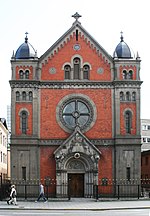Our website is made possible by displaying online advertisements to our visitors.
Please consider supporting us by disabling your ad blocker.
Catholic Church in Sweden
This article needs additional citations for verification. (February 2021) |
Catholic Church in Sweden | |
|---|---|
| Swedish: Katolska kyrkan i Sverige | |
 | |
| Classification | Catholic |
| Orientation | Latin |
| Scripture | Bible |
| Theology | Catholic theology |
| Polity | Episcopal |
| Governance | Scandinavian Bishops Conference |
| Structure | Diocese |
| Pope | Francis |
| Bishop | Cardinal Anders Arborelius |
| Apostolic Nuncio | James Green |
| Region | Sweden |
| Language | Swedish, English, Latin |
| Founder | St. Ansgar |
| Origin | Circa 826[1] 1594-1599 de facto reestablished by King Sigismund of Sweden 1781 legally reestablished as an apostolic vicariate |
| Separations | Church of Sweden |
| Members | Circa 125,000 registered members (circa 150,000 unofficially)[2] |
| Official website | Catholic Church in Sweden (English) |
| Part of a series on the |
| Catholic Church by country |
|---|
 |
|
|
The Catholic Church in Sweden is part of the worldwide Catholic Church in communion with the Pope in Rome. It was established by Archbishop Ansgar in Birka in 829, and further developed by the Christianization of Sweden in the 9th century. King Olof Skötkonung (ca. 970–1021) is considered the first Christian king of Sweden.
In the Middle Ages, continental culture, philosophy and science spread to Sweden through the Catholic Church, which also founded schools, Uppsala University, hospitals as well as monasteries and convents. Several church representatives also became significant actors outside the religious sphere.
The Reformation in Sweden began in 1527 when King Gustav Vasa and his Riksdag of Västerås broke the full communion of the Swedish church with Rome, making it politically subservient to the kingdom. Controversies about the state of Catholicism in the Swedish church endured until the reigns of King John III (1568–1592) and the Catholic King Sigismund of Poland and Sweden (1592–1599).
At the Uppsala Synod in 1593, under the influence of Duke and future King Charles IX of Sweden, the Swedish church finally became a Lutheran state church, ratified by Charles' victory in his war against his Catholic predecessor in 1599. Governmental anti-Catholicism was imposed in Sweden, including deportations and death penalties for Catholics from 1599 to 1781.
Limited visits of individual foreign Catholics in Sweden were decriminalised through the Tolerance Act, imposed in 1781 by King Gustav III of Sweden. The conversion of Swedish citizens to the Catholic Church was decriminalized in 1860. In 1951, Swedish citizens were allowed to exit from the Lutheran Church of Sweden. In 1977, the last legislative ban on Catholic convents in Sweden was abolished. Still, however, according to the Act of Succession of the Swedish throne, only Lutheran legitimate descendants brought up in Sweden are presently entitled to succeed as monarch and the thus head of state of Sweden.
Since 1953, the Catholic Church in Sweden has been formally represented by the Diocese of Stockholm, covering the whole country, estimating some 106,873 registered members (2013), with unofficial estimates of about 150,000 Catholics in the country in total. Most of them have an immigrant background, while others are native Swede converts.

On 21 May 2017, Pope Francis named Bishop Anders Arborelius, the Ordinary of Stockholm, a Cardinal, a first for the Catholic Church in Sweden.[3]
- ^ Radio, Sveriges (21 February 2007). "Fynd i Varnhem ändrar historien - P4 Skaraborg". Sveriges Radio.
- ^ "Stockholms katolska stift | Katolska kyrkan". www.katolskakyrkan.se.
- ^ "Vatican Radio". en.radiovaticano.va. Retrieved 25 May 2017.
Previous Page Next Page
Římskokatolická církev ve Švédsku Czech Römisch-katholische Kirche in Schweden German Katolinen kirkko Ruotsissa Finnish Église catholique en Suède French Katolička Crkva u Švedskoj Croatian Gereja Katolik di Swedia ID Chiesa cattolica in Svezia Italian Katholieke Kerk in Zweden Dutch Igreja Católica na Suécia Portuguese Romersk-katolska kyrkan i Sverige Swedish


